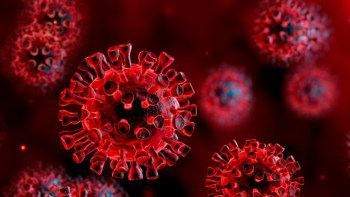A flexible sensor array that can be integrated into a sweatband and detect molecules like glucose in perspiration has been unveiled by researchers at the University of California at Berkeley and Stanford University in the US. Based on plastic- and silicon-integrated circuits, the new device can be worn on various parts of the body, such as the forehead or arms, and could be used to obtain information about a person’s physiology and health in almost real time.
Most commercially available glucose sensors detect glucose levels in blood, which means that the patient has to go through the painful ordeal of pricking their finger several times a day and dabbing the sensor with blood. The new device was developed by a team led by Berkeley’s Ali Javey and is completely non-invasive. It can detect the levels of sodium, potassium and lactate (which is the same as the lactic acid produced by active muscles) as well as glucose in a person’s sweat. It also measures skin temperature.
Sweat contains hundreds of different molecules – from simple ions like sodium and potassium, to more complex protein molecules, as well as heavy metals such as cadmium and mercury. Today, sweat analysis is mainly carried out in medical laboratories and most clinics are ill equipped to study the tiny volumes of liquid involved.
The team’s sensor can be worn directly on the skin and analyses sweat as it appears on the skin’s surface. The device contains an array of five sensors on a flexible substrate and can identify a single type of ion or molecule among thousands of others in a sample, depending on the electrical signals it produces.
Temperature dependence
“The more glucose or lactate in your sweat, for example, the more electrical current is generated at the sensor surface, and the more sodium and potassium, the larger the voltage,” explain team-members Wei Gao and Sam Emaminejad at Berkeley. “But the current generated from glucose and lactate sensors is affected by temperature. When your skin temperature goes up, the higher temperature increases the signal from the glucose sensor, making it look like you are releasing more glucose in your sweat than you actually are. As a result, it’s important to measure both temperature and molecules at the same time, to calibrate the device.”
The device can wirelessly transmit information via Bluetooth and the researchers say that they have already developed an application to synchronize the data obtained from the sensor to a mobile phone. Indeed, they have fitted the device onto “smart” wristbands and headbands. Because the device is fabricated on a mechanically flexible polyethylene-terephthalate (PET) substrate, it can easily be in contact with skin. There are two versions of the device: a completely flexible and disposable sensor array that binds to the skin like a temporary tattoo, and a flexible printed circuit board that is re-usable. The team tested out its devices on dozens of volunteers as they exercised, with their experiments lasting from a few minutes to more than an hour.
Large-scale clinical studies
The sensor might easily be miniaturized further, say Gao and Emaminejad. “The number of biochemicals we target can also be ramped up so we can measure a lot of things at once. That makes large-scale clinical studies possible, which will help us better understand athletic performance and physiological responses to exercise.”
Team member and exercise physiologist at Berkeley George Brooks says that although the device can be used to measure vital metabolites and electrolyte levels in the sweat of healthy individuals, it could also be adapted to monitor body fluids other than the perspiration of patients suffering from illness or injury. It might even be used to detect the presence of illegal drugs in sweat, which would be useful in anti-doping tests for athletes.
The research is described in Nature.
- A version of this article first appeared on nanotechweb.org



